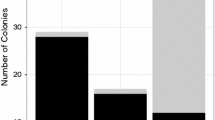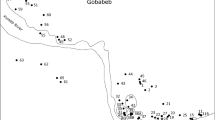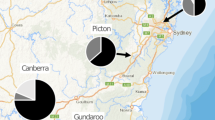Summary
The genetic and social structures of polygyne and monogyne forms of the fire ant, Solenopsis invicta, are investigated in a comparative manner using allozyme data from two polymorphic loci. Foundress queens of the monogyne form are signly inseminated and appear to produce all males present in the colony during the major summer mating flights. The average regression coefficient of relatedness (b) among female nestmates of the monogyne form is 0.714 (Fig. 2), statistically indistinguishable from the pedigree coefficient of relatedness (G) of 0.75. We suggest that the evolution of obligate worker sterility in Solenopsis is associated with this high relatedness between workers and the queens they rear. Functional queens in polygyne nests also are singly inseminated and are no more closely related to nestmate queens than to other queens (within-nest b=0). Within-nest relatedness of workers in the polygyne population is similarly low (Fig. 2). Both the monogyne and polygyne populations from northcentral Georgia are in Hardy-Weinberg equilibrium at both allozyme loci and we found no evidence of significant population subdividion or inbreeding in the polygyne population. These results do not support the view that kin selection has promoted the evolution of polygyny in North American S. invicta. Rather, mutualism appears to be the most likely selective factor mediating queen associations inthis ant.
Similar content being viewed by others
References
Ayala FJ, Powell JR (1972) Allozymes as diagnostic characters of sibling species of Drosophila. Proc Natl Acad Sci USA 69:1094–1096
Ball DE, Vinson SB (1983) Mating in the fire ant, Solenopsis invicta Buren: evidence that alates mate only once. J Ga Entomol Soc 18:287–291
Banks WA, Lofgren CS, Jouvenaz DP, Stringer CE, Bishop PM, Williams DF, Wojcik DP, Glancey BM (1981) Techniques for collecting, rearing, and handling imported fire ants. USDA/SEA publication AAT-S-21, April
Bartz SH, Hölldobler B (1982) Colony founding in Myrmecocystus mimicus Wheeler (Hymenoptera: Formicidae) and the evolution of foundress associations. Behav Ecol Sociobiol 10:137–147
Brian MV (1983) Social insects, ecology and behavioural biology. Chapman and Hall, London
Brian MV, Brian AD (1955) On the two forms macrogyna and microgyna of the ant Myrmica rubra L. Evolution 9:280–290
Buth DG (1984) The application of electrophoretic data in systematic studies. Annu Rev Ecol Syst 15:501–522
Clayton JW, Tretiak DN (1972) Amine-citrate buffers for pH control in starch gel electrophoresis. J Fish Res Board Can 29:1169–1172
Cole BJ (1983) Multiple mating and the evolution of social behavior in the Hymenoptera. Behav Ecol Sociobiol 12:191–201
Craig R, Crozier RH (1979) Relatedness in the polygynous ant Myrmecia pilosula. Evolution 33:335–341
Crozier RH (1970) Coefficients of relationship and the identity of genes by descent in the Hymenoptera. Am Nat 104:216–217
Crozier RH (1973) Apparent differential selection at an isozyme locus between queens and workers of the ant Aphaenogaster rudis. Genetics 73:313–318
Crozier RH (1974) Allozyme analysis of reproductive strategy in the ant Aphaenogaster rudis. Isozyme Bull 7:18
Crozier RH (1977) Evolutionary genetics of the Hymenoptera. Annu Rev Entomol 22:263–288
Crozier RH (1979) Genetics of sociality. In: Hermann HR (ed) Social insects, vol I. Academic, New York, pp 223–286
Crozier RH, Pamilo P, Crozier YC (1984) Relatedness and microgeographic genetic variation in Rhytidoponera mayri, an Australian arid-zone ant. Behav Ecol Sociobiol 15:143–150
Elmes GW (1978) Populations of Myrmica (Formicidae) living on different types of Calluna moorland — a semi-natural habitat of southern England. Memorabilia Zool 29:41–60
Felsenstein J (1981) Evolutionary trees from gene frequencies and quantitative characters: finding maximum likelihood estimates. Evolution 35:1229–1242
Fletcher DJC (1983) Three newly discovered polygynous populations of the fire ant, Solenopsis invicta, and their significance. J Ga Entomol Soc 18:538–543
Fletcher DJC, Blum MS (1983a) Regulation of queen number by workers in colonies of social insects. Science 219:312–314
Fletcher DJC, Blum MS (1983b) The inhibitory pheromone of queen fire ants: effects of disinhibition on dealation and oviposition by virgin queens. J Comp Physiol 153:467–475
Fletcher DJC, Ross KG (1985) Regulation of reproduction in eusocial Hymenoptera. Annu Rev Entomol 30:319–343
Fletcher DJC, Blum MS, Whitt TV, Temple N (1980) Monogyny and polygyny in the fire ant, Solenopsis invicta. Ann Entomol Soc Am 73:658–661
Glancey BM, Craig CH, Stringer CE, Bishop PM (1973) Multiple fertile queens in colonies of the imported fire ant, Solenopsis invicta. J Ga Entomol Soc 8:237–238
Greenberg L, Fletcher DJC, Vinson SB (1985) Differences in worker size and mound distribution in monogynous and polygynous colonies of the fire ant, Solenopsis invicta Buren. J Kans Entomol Soc 58:9–18
Hamilton WD (1964) The genetical evolution of social behaviour. J Theor Biol 7:1–52
Hamilton WD (1972) Altruism and related phenomena, mainly in soical insects. Annu Rev Ecol Syst 3:193–232
Harris H, Hopkinson DA (1976) Handbook of enzyme electrophoresis in human genetics. North-Holland, New York
Hartl DL (1971) Some aspects of natural selection in arrhenotokous populations. Am Zool 11:309–325
Hartl DL (1980) Principles of population genetics. Sinauer, Sunderland, Mass
Higashi S (1979) Polygyny, nest-budding and internest mixture of individuals in Formica (Serviformica) japonica Mostchulsky at Ishikari shore. Kontyu 47:381–389
Hölldobler B, Wilson EO (1977) The number of queens: an important trait in ant evolution. Naturwissenschaften 64:8–15
Hung ACF, Vinson SB (1976) Biochemical evidence for queen monogamy and sterile male diploidy in the fire ant Solenopsis invicta. Isozyme Bull 9:55
Hung ACF, Vinson SB, Summerlin JW (1974) Male sterility in the red imported fire ant, Solenopsis invicta. Ann Entomol Soc Am 67:909–912
Hung ACF, Dowler MG, Vinson SB (1979) Electrophoretic variants of α-glycerophosphate dehydrogenase in the fire and Solenopsis invicta. Can J Genet Cytol 21:537–542
Johnson FM, Schaffer HE, Gillapsy JE, Rockwood ES (1969) Isozyme genotype-environment relationships in natural populations of the harvester ant, Pogonomyrmex barbatus, from Texas. Biochem Genet 3:429–450
Jouvenaz DP, Allen GE, Banks WA, Wojcik DP (1977) A survey for pathogens of fire ants, Solenopsis spp. in the southeastern United States. Fla Entomol 60:275–279
Li CC, Horvitz DG (1953) Some methods of estimating the inbreeding coefficient. Am J Hum Genet 5:107–117
Lin N, Michener CD (1972) Evolution of sociality in insects. Q Rev Biol 47:131–159
May B, Wright JE, Stoneking M (1979) Joint segregation of biochemical loci in Salmonidae: results from experiments with Salvelinus and review of the literature on other species. J Fish Res Borad Can 36:1114–1128
Mirenda JT, Vinson SB (1982) Single and multiple queen colonies of imported fire ants in Texas. SW Entomol 7:135–141
Morrill WL (1974) Production and flight of alate red imported fire ants. Environ Entomol 3:265–271
Nei M (1977) F-statistics and analysis of gene diversity in subdivided populations. Ann Hum Genet (Lond) 41:225–233
O'Neal J, Markin GP (1975) Brood development of the various eastes of the imported fire ant, Solenopsis invicta Buren (Hymenoptera: Formicidae). J Kans Entomol Soc 48:152–159
Page RE, Metcalf RA (1982) Multiple mating, sperm utilization, and social evolution. Am Nat 119:263–281
Pamilo P (1981) Genetic organization of Formica sanguinea populations. Behav Ecol Sociobiol 9:45–50
Pamilo P (1982) Genetic population structure in polygynous Formica ants. Heredity 48:95–106
Pamilo P (1983) Genetic differentiation within subdivided populations of Formica ants. Evolution 37:1010–1022
Pamilo P, Crozier RH (1982) Measuring genetic relatedness in natural populations: methodology. Theor Popul Biol 21:171–193
Pamilo P, Rosengren R (1984) Evolution of nesting strategies of ants: genetic evidence from different population types of Formica ants. Biol J Linn Soc 21:331–348
Pamilo P, Varvio-Aho S-L (1979) Genetic structure of nests in the ant Formica sanguinea. Behav Ecol Sociobiol 6:91–98
Pearson B (1982) Relatedness of normal queens (macrogynes) in nests of the polygynous ant Myrmica rubra Latreille. Evolution 36:107–112
Pearson B (1983) Intra-colonial relatedness amongst workers in a population of nests of the polygynous ant, Myrmica rubra Latreille Behav Ecol Sociobiol 12:1–4
Rogers JS (1984) Deriving phylogenetic trees from allele frequencies. Syst Zool 33:52–63
Ross KG, Fletcher DJC (1985) Genetic origin of male diploidy in the fire ant, Solenopsis invicta (Hymenoptera: Formicidae), and its evolutionary significance. Evolution (in press)
Ross KG, Fletcher DJC, May B (1985) Enzyme polymorphisms in the fire ant, Solenopsis invicta (Hymenoptera: Formicidae). Biochem Syst Ecol 13:29–33
Scherba G (1961) Nest structure and reproduction in the mound-buiding ant Formica opaciventris Emery in Wyoming. J NY Entomol Soc 69:71–87
Shaw CR, Prasad R (1970) Starch gel electrophoresis of enzymes — a compilation of recipes. Biochem Genet 4:297–320
Snedecor GW, Cochran WG (1980) Statistical methods. 6th edn, Iowa State University Press, Ames
Spiess EB (1977) Genes in populations. Wiley, New York
Talbot M (1948) A comparison of two ants of the genus Formica. Ecology 29:316–326
Thorne BL (1984) Polygyny in the neotropical termite Nasutitermes corniger: life history consequences of queen mutualism. Behav Ecol Sociobiol 14:117–136
Tschinkel WR, Nierenberg NCE (1983) Possible importance of relatedness in the fire ant, Solenopsis invicta Buren (Hymenoptera: Formicidae) in the United States. Ann Entomol Soc Am 76:989–991
Utter FM, Hodgins HO, Allendorf FW (1974) Biochemical genetic studies of fishes: potentialities and limitations. Biochem Biophys Persp Mar Biol 1:213–238
Ward PS (1983) Genetic relatedness and colony organization in a species complex of ponerine ants. I. Phenotypic and genotypic composition of colonies. Behav Ecol Sociobiol 12:285–299
West-Eberhard MJ (1981) Intragroup selection and the evolution of insect societies. In: Alexander RD, Tinkle DW (eds) Natural selection and social behavior. Chiron, New York pp 3–17
Wilson EO (1971) The insect societies. Belknap, Cambridge
Wright S (1978) Evolution and the genetics of populations, vol IV, Variability within and among natural populations. University of Chicago Press, Chicago
Yamauchi K, Kinomura K, Miyake S (1981) Sociobiological studies of the polygynic ant Lasius sakagamii. I General features of its polydomous system. Insectes Soc 28:279–296
Author information
Authors and Affiliations
Rights and permissions
About this article
Cite this article
Ross, K.G., Fletcher, D.J.C. Comparative study of genetic and social structure in two forms of the fire ant Solenopsis invicta (Hymenoptera: Formicidae). Behav Ecol Sociobiol 17, 349–356 (1985). https://doi.org/10.1007/BF00293212
Received:
Accepted:
Issue Date:
DOI: https://doi.org/10.1007/BF00293212




